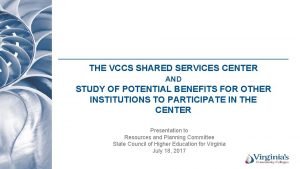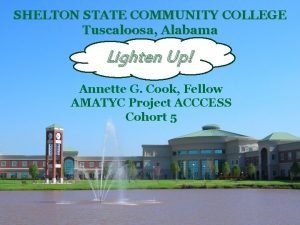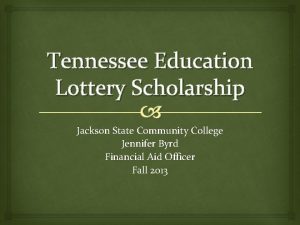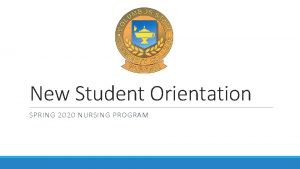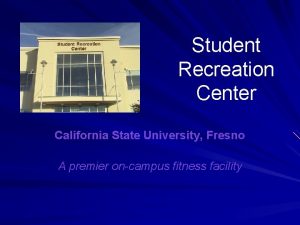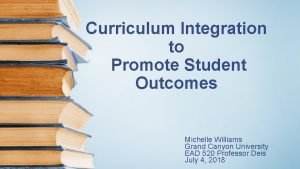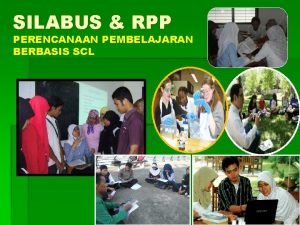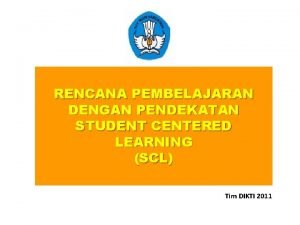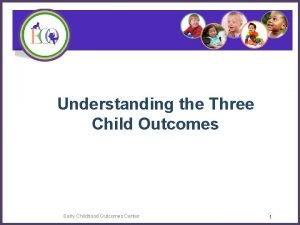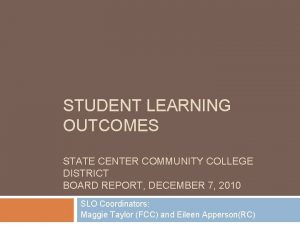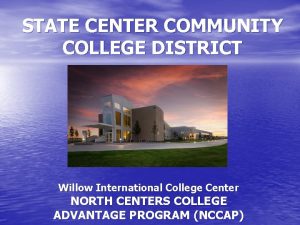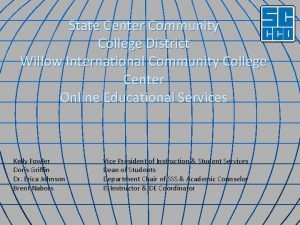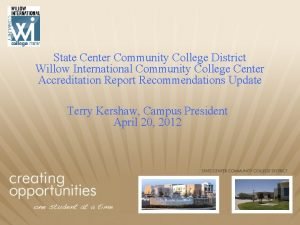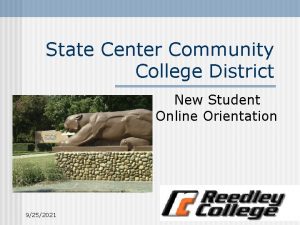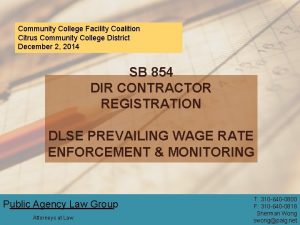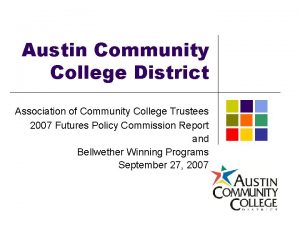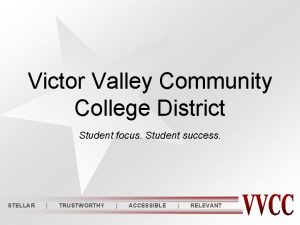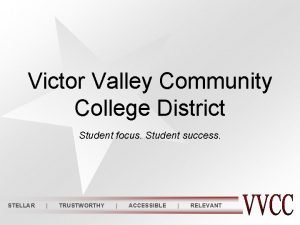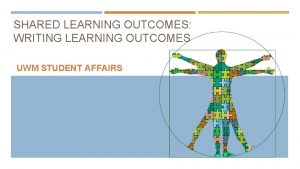STUDENT LEARNING OUTCOMES STATE CENTER COMMUNITY COLLEGE DISTRICT















- Slides: 15

STUDENT LEARNING OUTCOMES STATE CENTER COMMUNITY COLLEGE DISTRICT BOARD REPORT, DECEMBER 7, 2010 SLO Coordinators: Maggie Taylor (FCC) and Eileen Apperson(RC)

What does ACCJC say? The 2002 Accreditation Standards and Eligibility Requirements placed an increased emphasis on the assessment of student learning as means of evaluating and improving the educational effectiveness of institutions. Two standards that deal with learning outcomes are Standard IB and Standard II A. 1. c. SLO Presentation, SCCCD, BOT, 12 -7 -2010

ACCJC Standard 1 B Improving Institutional Effectiveness “The institution demonstrates a conscious effort to produce and support student learning, measures that learning, assesses how well learning is occurring, and makes changes to improve student learning. ” SLO Presentation, SCCCD, BOT, 12 -7 -2010

ACCJC Standard II A 1. c. Student Learning Programs and Services “The institution identifies student learning outcomes for courses, programs, certificates, and degrees; assesses student achievement of those outcomes; and uses assessment results to make improvements. ” SLO Presentation, SCCCD, BOT, 12 -7 -2010

What are Student Learning Outcomes? Student Learning Outcomes are meaningful and measureable means to improve learning as established by discipline faculty and student services experts. Instructional SLOs are based upon the Course Outline of Record. SLO statements reflect where a student should be upon successful completion of a college course, program, certificate, or degree. SLOs must be established and assessed at the course, program (both instructional and noninstructional), degree, and institutional levels. SLO Presentation, SCCCD, BOT, 12 -7 -2010

SLO Example at FCC Institutional Learning Outcome: Students will demonstrate critical thinking skills in problem solving. Degree SLO: Child Development AS Degree Design, implement and evaluate environments and activities that support positive developmental play and learning outcomes for all young children. Course SLO: CDHEV 1 Assess early childhood settings, curriculum, and teaching strategies utilizing indicators of quality early childhood practice that support all children including those with diverse characteristics. Assessment occurs at the course level.

SLO Example at RC Institutional Learning Outcomes: 1. Interpret various types of written, visual, and verbal information. 4. Employ critical and creative modes of inquiry to solve problems, explore alternatives, and make decisions. 7. Apply historical and contemporary issues and events to civic and social responsibility. Program SLO: History Identify important people, events, and factors influencing the direction of human history. Course SLO: History 11 Outcome 1: Identify the origins of America’s distinctive political traditions and governmental institutions. Assessment occurs at the course level.

The positive outcomes from assessment include: Keeping our focus on a student-centered environment � Creating an atmosphere beyond assessment (which implies an end) to an atmosphere of ongoing dialogue, adjustment, and creativity � Giving departments a framework to re-examine how students move through a series of courses or services � Giving us more specific feedback on how effective we are with student learning � Creating opportunities to discuss best teaching practices among full-time and part-time faculty � Helping students see the relevance in and connections between their classes � Strengthening student success � SLO Presentation, SCCCD, BOT, 12 -7 -2010

Direct Assessment Measures • • • Portfolio assessments Locally developed tests, including pre and post tests Internship/service evaluations Standardized departmental exams Licensure certifications/professional exams Course-embedded assessments SLO Presentation, SCCCD, BOT, 12 -7 -2010

Indirect Assessment Measures • • • GPA and transfer comparisons Graduation rates Job placement data Graduate follow-up studies Retention and transfer studies Surveys of alumni, employers, faculty, administrators and students SLO Presentation, SCCCD, BOT, 12 -7 -2010

ACCJC Standard 1. B. 3 Improving Institutional Effectiveness Requires institutions “assess progress toward achieving stated goals and make decisions regarding the improvement of institutional effectiveness in an ongoing and systematic cycle of evaluation, integrated planning, resource allocation, implementation and reevaluation. ” SLO Presentation, SCCCD, BOT, 12 -7 -2010

“Integrated Planning to Implement College Quality Improvement” “Integrated planning is neither top-down nor bottom-up; it is an interactive process in which an institution, through its governance processes, thoughtfully uses its values and vision to set priorities and deploy its resources and energies to achieve institutional changes and improvements at various levels of the organization in response to current or anticipated conditions. ” (ACCJC News, Fall 2009) SLO Presentation, SCCCD, BOT, 12 -7 -2010

Integrated Planning SLOs have become an integral part of the decision making process and planning. SLOs and assessment are now part of program review. Program review is instrumental to the planning process and allocation of resources. As with other college processes, integrated planning, including SLOs, has included all constituents groups. SLO Presentation, SCCCD, BOT, 12 -7 -2010

Integrated Planning By 2012, the colleges are expected to use the assessment results for improvement and further alignment of institution-wide practices. SLO Presentation, SCCCD, BOT, 12 -7 -2010

Course & Program SLO Cycle Course/Program Goals Course/Program Objectives Course/Program Improvements Colleg e Missi on Course/Program Assessment and Evaluation SLO Presentation, SCCCD, BOT, 12 -7 -2010 Course/Program Outcomes (SLOs)
 Ncbts student learning outcomes
Ncbts student learning outcomes Domain 4 in ppst
Domain 4 in ppst Vccs
Vccs Chaffey college chino community center
Chaffey college chino community center Sls moe login
Sls moe login Www.sheltonstate.edu
Www.sheltonstate.edu Jweb jscc
Jweb jscc Cscc lpn program
Cscc lpn program Student recreation center fresno state
Student recreation center fresno state Isu academic success center
Isu academic success center Ead 520
Ead 520 Rpp berbasis student center learning (scl)
Rpp berbasis student center learning (scl) Contoh rpp berbasis student centered learning kelas 1 sd
Contoh rpp berbasis student centered learning kelas 1 sd Early childhood outcomes center
Early childhood outcomes center Example of learning outcomes
Example of learning outcomes Water cycle learning outcomes
Water cycle learning outcomes


